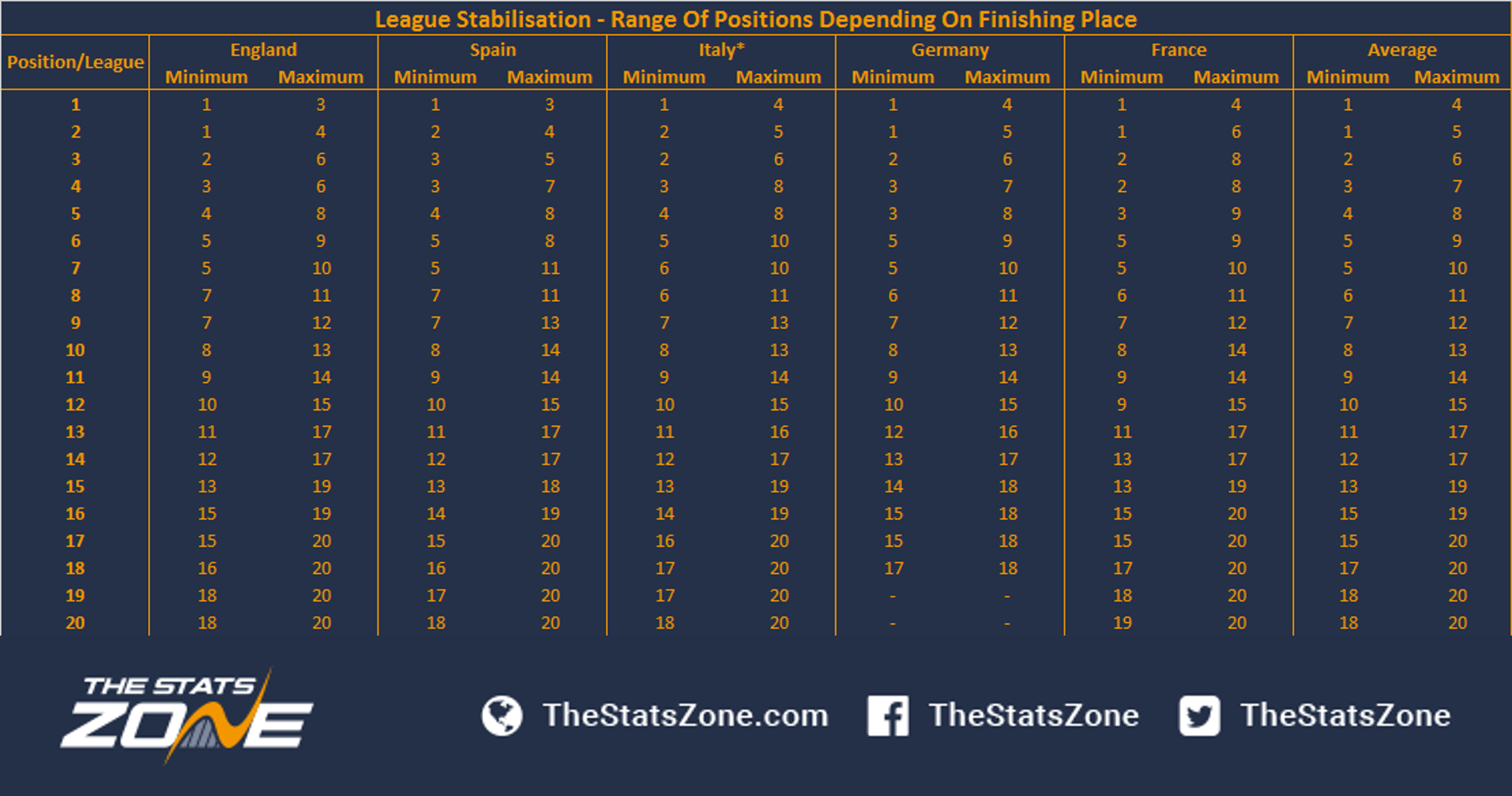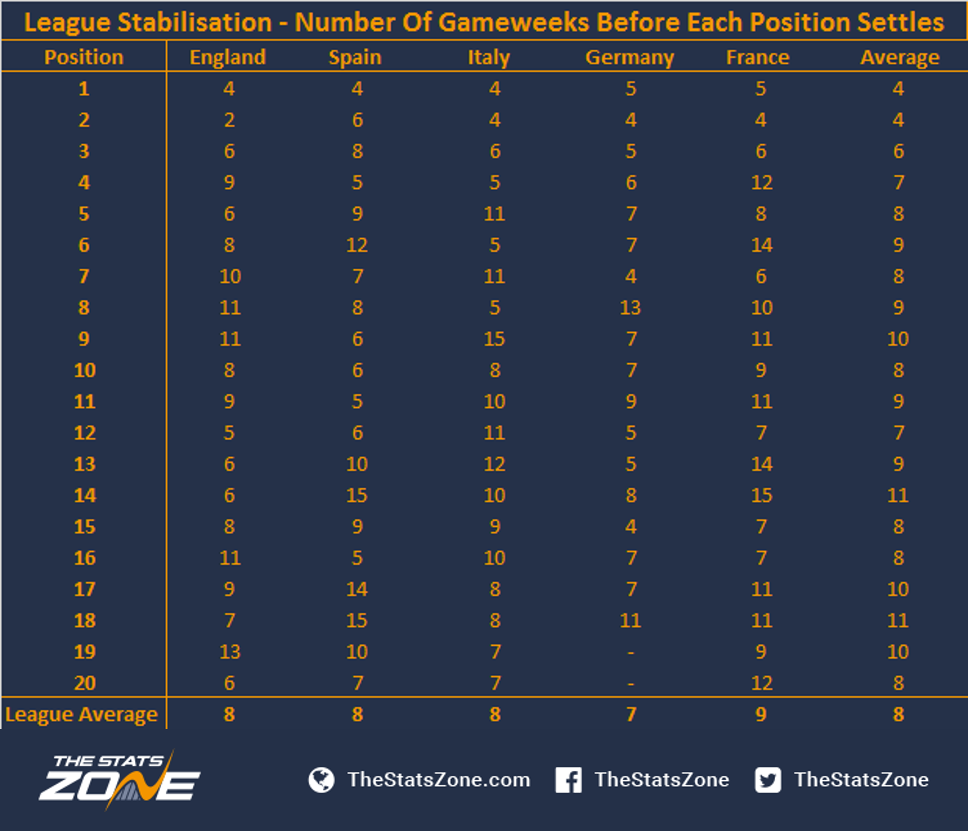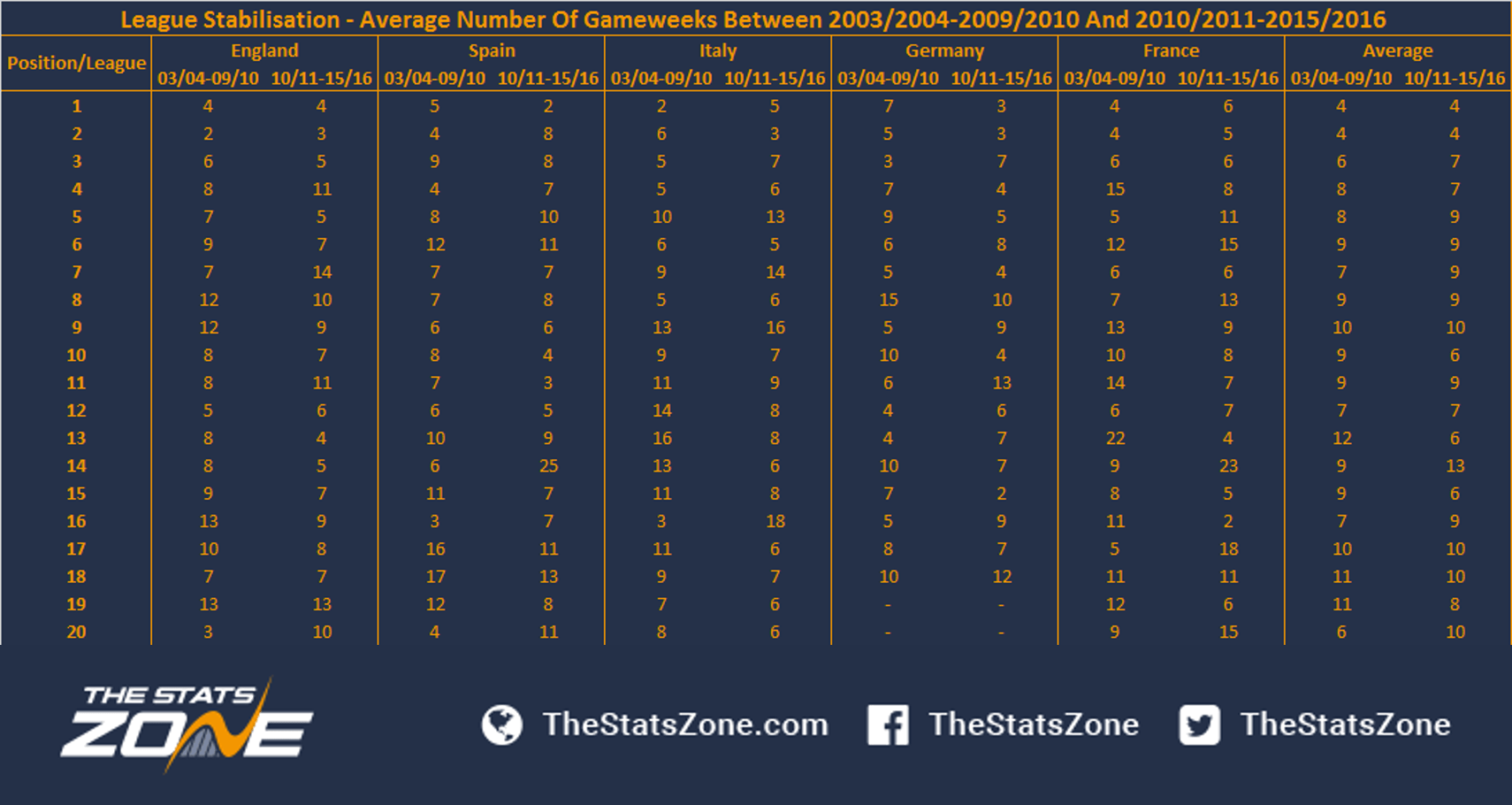At What Point In The Season Do League Tables Take Shape?
After a long wait, the top European football leagues are back! At this early stage of the season, the first few rounds of a football league usually sees several changes of positions on both a large and small scale, which often will not reflect how the league table will look come the end of the season. So, in order to understand when these league tables begin to take shape, The Stats Zone has decided to identify at which round clubs usually reach the zone of their final position. We’ve done this by analysing the top five European Leagues from the 2003/2004 season to the 2015/2016 season.
In order to set each position zone range, the standard deviation of all the positions the clubs were positioned throughout a season was taken, which was then added and subtracted on the average of these positions. For instance, suppose a club that finished the league in first place was actually in third place after the first round of fixtures, in fourth position in the second round of fixtures, and in first position until the end of a ten games season. So, the standard deviation would be calculated from the sample [3,4,1,1,1,1,1,1,1,1].
 *The Serie A season 2006/2007 was not taken into account due to several clubs starting with negative points, which affects the average and standard deviation of the sample
*The Serie A season 2006/2007 was not taken into account due to several clubs starting with negative points, which affects the average and standard deviation of the sample
Looking at the table above, the position ranges are very similar between the leagues. Also, on average, only four clubs usually enjoy the top three positions throughout a season, whilst double the number of clubs are usually positioned within the bottom three positions. This fact is a result of having a few clubs with a great potential while at the same time having several clubs struggling to maintain a good performance due to the high balance between them.
In order to identify on which round a club usually enters its final position zone range, the analysis considered the first time the club entered in its final position range and remained for at least two consecutive rounds within that range, owing to the fact that in the first few rounds the randomness of the league table is high and thus, would avoid a causality of a club within the range. For instance, in the 2007/2008 season, Almería finished the league in eighth position, which has a zone range between seventh and eleventh. The club finished the first round in second, then entered in its zone range in the second round, after that left the zone range in the two following rounds, then entered again in the fifth round, and again left for another two rounds, followed by a coming and going until the 15th round, when finally the club seemed to stabilise in its final position zone range.

By applying this methodology, we could identify that the five leagues have similar overall averages. The German league has a smaller average, possibly due to the competition containing fewer rounds than the other competitions, whilst the French league seems to be slightly more competitive by having a greater final average. Furthermore, looking at first place, both leagues are slightly more competitive than the others. However, looking at the second and third position, the Spanish league, which is widely known for being the least competitive league within the sample owing to the long term superiority of Real Madrid and Barcelona, surprisingly seems to be the most competitive when considering the second and third position. On the other hand, the English league – which is also widely known for being the most competitive league, especially due to the potential competitiveness between the clubs as a result of the revenue sharing policies – unexpectedly has the least competitive dispute for the last position, while the German and the French league seem to be more competitive in the last position battle, indicating that the weakest club of these leagues tends to resist for a longer period.

Nevertheless, looking at the league table zones below, the French league seems to be more competitive at the beginning of the competition, due to the top four clubs usually taking longer to reach the top four zone range, the middle table clubs also take longer to reach their positions, and the bottom table clubs are the second ranked within the number of rounds taken to reach their zone range. On the other hand, perhaps due to the fewer number of rounds, the German league clubs take less time to reach their final position zone range. Nonetheless, the averages indicate that the top four clubs usually reach their final position zone range in the sixth round, while the other clubs take three more rounds to reach their positions by reaching it in the ninth round.

In an alternative analysis, as the sample involves different eras of the competitions, the sample was halved to analyse the differences between the seasons 2003/2004 - 2009/2010 and 2010/2011-2015/2016.

Looking at the table above, it can be seen that the English champion still takes four rounds to reach the first position zone range, while in Spain and Germany the champion is taking fewer rounds than before. On the other hand, in Italy and France, the champion is taking longer. However, analysing the average of the five leagues, both the champion and the runners-up took, on average, four rounds to reach their respective zone range in both periods, indicating no significant change in the top leagues average. On the other side of the league table, there are significant changes in the last place battle, until the 2010/2011 season, where the last place took, on average, only six rounds to reach its zone range, however after that season, the last place took, on average, ten rounds to reach its zone rage. The substantial changes come mostly from England (three to ten rounds), Spain (four to eleven rounds) and France (nine to 15 rounds). Moreover, the table indicates that most of the significant changes between the two halves happened in the middle table zone. Nonetheless, there are remarkable changes in the relegation zone of the leagues, where the last club is taking longer to reach its zone range, and the 18th and the 19th position are taking fewer rounds to reach their zone range.
Hence, even having to wait a long time for the beginning of the European football season, it will be a little while yet (an average of eight rounds) before the league’s take a consistent shape. So, according to each league average in the season 2016/2017, it is expected that all the five leagues will have their league table shaped on the weekend of 15th October and 16th October 2016.











